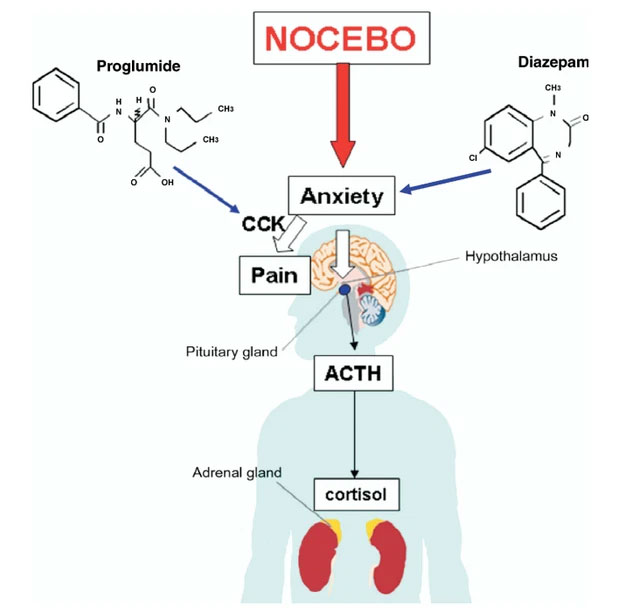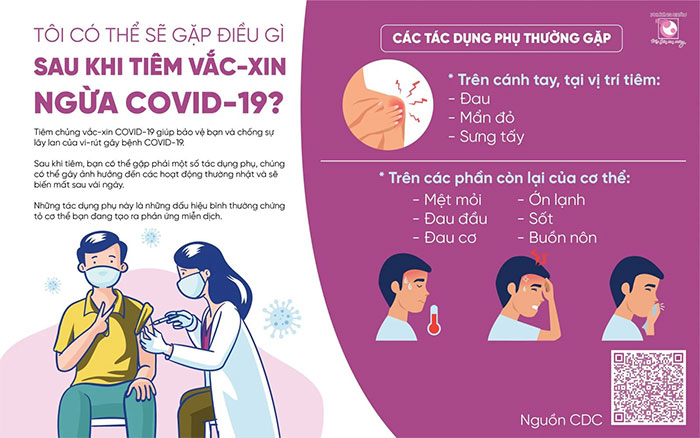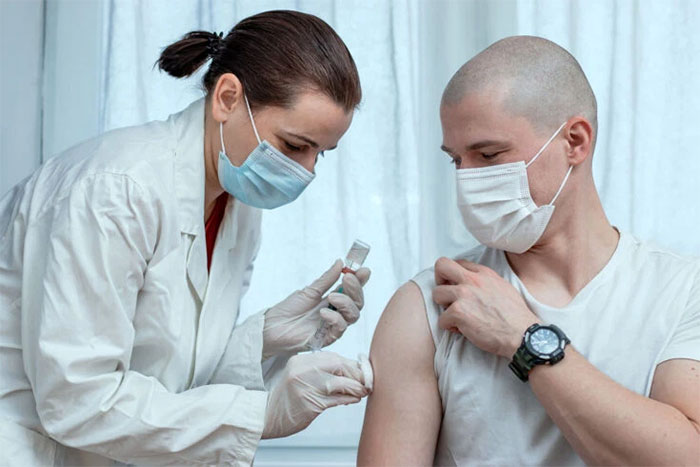The side effects of medications can be transmitted from one person to another through the nocebo effect. Therefore, if someone who has received a vaccine tells you that they experienced significant pain and fatigue, it is highly likely that you will also feel pain and fatigue after your vaccination.
How do you feel after receiving the Covid-19 vaccine? For me, the first shot was quite uncomfortable. For three consecutive days, I experienced fever, muscle aches, especially in the arm that received the shot, which swelled to the point where I could barely hold a towel.
The second shot two months later was more tolerable. I did not experience any of the above side effects again, except for a slight discomfort at the injection site. Most recently, the third shot brought back some of the experiences from the first shot, but all side effects were mild and did not last more than a day.

Common symptoms after receiving the Covid-19 vaccine.
I used to think that the order of these experiences was a given; when your body first encounters a completely new vaccine, your immune system will react the strongest. Subsequent booster shots would naturally be milder, as the body becomes accustomed to the presence of Covid-19 antigens.
However, after reading a study in the JAMA Network Open journal, I began to wonder if things might not occur as naturally as I thought. Especially with the first shot, it seemed I had fallen victim to an effect known as nocebo, where excessive side effects of the vaccine were merely a result of imagination.
I had imagined myself having a fever just to justify taking two days off, believing I was exhausted because a friend who had been vaccinated before said so. As for the swollen arm, it may have indeed been swollen—but only a little, not as severely as I described.
All the side effects of the Covid-19 vaccine, for me, turned out to be just the nocebo effect.
What is the nocebo effect?
Nocebo in Latin means “I will harm you“. This term was first used by American physician Walter Kennedy in 1961 to refer to a person’s negative expectations regarding a medical treatment that lead to its negative side effects.
Nocebo, therefore, originates from the very imagination of the patient rather than from the actual pharmacological properties of the drug or treatment. For example, when you read the instructions for a medication and pay too much attention or worry about the listed side effects, you are more likely to experience those side effects in real life.
Hundreds of studies and randomized controlled trials conducted over the past half-century have shown that when doctors carefully explain the side effects of a medication to two groups of patients, giving one group the actual medication and the other a placebo (which contains only inert substances like starch), both groups report experiencing the side effects explained by the doctor.
In the group that received the actual medication, these side effects can be attributed to the drug’s pharmacological effects. But in the placebo group, it is undoubtedly a nocebo phenomenon.
Even when the side effects of a drug are real, being influenced by nocebo can cause patients in the actual medication group to experience side effects more severely. This is also considered a form of nocebo.

Nocebo originates from the very imagination of the patient rather than from the drug’s pharmacological properties.
Returning to the recent study in the JAMA Network Open journal, the authors from Harvard Medical School analyzed a total of 12 clinical trials involving 45,380 people. Among them, 22,802 received the actual Covid-19 vaccine and 22,578 received a placebo (saline injection). None of the participants knew whether they had received the actual vaccine or the placebo.
After the first shot, 46.3% of those who received the actual vaccine reported systemic side effects, the most common being headache and fatigue. A higher rate, 66.7%, reported local side effects, such as pain or swelling at the injection site.
However, patients who received the placebo also experienced those side effects, with 35.2% reporting systemic effects and 16.2% reporting local side effects.
Based on the comparison of rates between the two groups, the analysis by the Harvard researchers concluded: The nocebo effect accounted for a total of 76% of systemic side effects and 24% of local effects after the first vaccine dose. The figure for the second dose was slightly lower, but still at 52%.
This means that many of us who feel pain at the injection site, fatigue, or even fever after receiving the Covid-19 vaccine are likely experiencing the nocebo effect, and I would count myself among those who have experienced it.
Why do our imaginations make nocebo a reality?
The origins of each specific nocebo effect remain largely a mystery to scientists. But one thing is certain: they know that nocebo is a product of the brain itself. Since placebos are entirely inert chemically, they cannot trigger any chemical reactions in your body.
But the human mind is quite the opposite; it is something very powerful. The mind not only has the ability to convince us to believe in something, but it can also cause the body to produce false symptoms based on various mysterious neural and biochemical pathways.

Example of the nocebo effect worsening pain.
Dr. John Kelley, deputy director of the placebo research program at Harvard Medical School, states: “That’s the power of imagination. If you ask someone to visualize a scene in their mind, you can see on MRI scans in their occipital lobe—the part of the brain associated with vision—being activated.
If you ask people to imagine doing some physical activity, you’ll see their motor cortex activate. Just imagining something happening is enough to activate areas of the brain associated with that thought, including anxiety or pain.
In the case where you think you will have a fever, fatigue, or arm pain after receiving the Covid-19 vaccine, it is possible that the very parts of your brain related to your responses to fever, fatigue, and pain are activated. And the brain begins to convince you to believe in it, through a series of biochemical reactions.
Scientists have found in placebo studies that the nocebo effect can enhance the perception of pain by inhibiting areas of the brain that release dopamine, a neurotransmitter that has pain-relieving effects, and increasing the release of cholecystokinin, a chemical that promotes pain in the body, making you more sensitive to it.
That is why I believe my pain after receiving the Covid-19 vaccine was merely imagined. And it was further activated by several other factors, more related to psychology.
Researchers studying nocebo effects indicate that this phenomenon can be more strongly triggered by how doctors and nurses discuss medication side effects. A 2016 study in the journal Pharmacology, Research & Perspectives showed that the more doctors talked about the negative effects of a treatment, the stronger the nocebo effect was activated.
This is exactly what I experienced during my first Covid-19 vaccine shot. The doctors provided me with a follow-up guide listing all the vaccine’s side effects and explained them in detail.
But by the second and third shots, the vaccination unit no longer provided me with those follow-up guides, and strangely, the side effects of the vaccine were also milder or even disappeared.

Ted J. Kaptchuk, one of the authors of the recent study at Harvard Medical School and a leading researcher in the field of placebos, states: “Many information leaflets list non-specific reactions after receiving the Covid-19 vaccine, such as headaches and fatigue. These are also symptoms that have been shown to be particularly sensitive to nocebo.
Evidence suggests that this type of information can lead people to misattribute their basic sensations that they usually experience daily to the vaccine, or cause them to worry and pay excessive attention to their bodily sensations and adverse events.
The second psychological factor that triggers the nocebo effect is past treatment experiences. If you ask someone who has previously received the Covid-19 vaccine about the side effects they experienced, and they describe them in detail or exaggerate them, you are likely to experience similar side effects because you have planted an expectation in your mind.
Similarly, studies indicate that media coverage, Google searches, and discussions on social media can also influence the nocebo effect.
Previous research has shown that as more people discuss statin-induced muscle pain online, an increasing number of patients report feeling more pain and discontinue their treatment, despite objective clinical trials indicating that statins do not cause muscle pain. Consequently, as more individuals stop taking statins, the rates of heart attacks and strokes among patients also rise.
Researchers suggest that a similar situation may apply to Covid-19. When many people express concerns about the side effects of vaccines, they may choose not to get vaccinated, thereby putting themselves at risk of contracting the disease.

Factors triggering the nocebo effect are past treatment experiences.
Factors that Trigger the Nocebo Effect: Self-imagination, information from drug instructions, or communication from doctors, along with experiences of others.
The cost of medication also influences the nocebo effect. In a 2017 experiment published in the journal Science, scientists allowed a group of volunteers to choose between an expensive or inexpensive topical cream, stating that both could relieve itching but had the side effect of causing skin irritation.
The results showed that those who chose the expensive cream reported feeling less itchy but experienced more skin irritation than those who opted for the cheaper cream. However, the first surprise was that the cream in both the expensive and cheap boxes was the same. The second surprise was that both were placebos, having no effect on itching or causing skin irritation.
In the case of Covid-19, the cost or type of vaccine may also affect the nocebo effect you experience. For instance, many people believe that the side effects of one vaccine are more severe than those of another, and the nocebo effect they experience after vaccination will correspond to their beliefs.
Ultimately, the Covid-19 pandemic itself and the anxiety surrounding vaccines also contribute to intensifying the nocebo effect. A 2020 study published in the journal Frontiers in Psychology stated that Covid-19 is “a perfect storm in which nocebo effects can flourish.”
When we are thrust into uncertain situations, exposed to a plethora of negative information about the pandemic and vaccines, while lacking positive reference information, the nocebo effect is more likely to manifest.
How to Mitigate the Nocebo Effect?
Clearly, the nocebo effect presents a dilemma for doctors. If they inform patients about potential risks and negative side effects of a treatment, patients may believe they will experience those harmful outcomes—and the nocebo effect can turn that belief into a self-fulfilling prophecy.
However, if doctors do not inform patients of the risks, they may face legal action, as medical laws and ethics require doctors to disclose all potential side effects of a therapy before obtaining informed consent from patients.
So what is the solution? Kaptchuk suggests that informing patients about the nocebo effect may help reduce the number of adverse reactions. “Medicine is based on trust,” he states.
“Our findings suggest that informing the public about the possibility of experiencing nocebo effects may help alleviate anxiety surrounding Covid-19 vaccinations, which could reduce vaccine hesitancy.“

Our psychology can be easily deceived, but we can also reassure ourselves.
Additionally, doctors can employ strategies to communicate side effects, such as presenting them alongside the positive effects of the medication to highlight the benefits over the drawbacks.
They can also explain that listing side effects of vaccines or including them in drug instructions is a mandatory activity, and not everyone will experience those side effects.
Therefore, instead of saying, “After vaccination, you may experience pain, fever, or fatigue,” doctors might choose a different statement: “Many people do not experience any side effects after vaccination; only a smaller portion report experiencing mild pain, fever, or fatigue.“
Rather than stating that a vaccine may put you at risk of anaphylaxis, doctors should emphasize that this is a very rare side effect. If possible, they should provide a statistic, such as one in two million vaccinated individuals experiencing such a situation.
For individuals, being aware that you might experience the nocebo effect after vaccination can also help you overcome it. Our psychology can be easily deceived, but we can also reassure ourselves.



















































